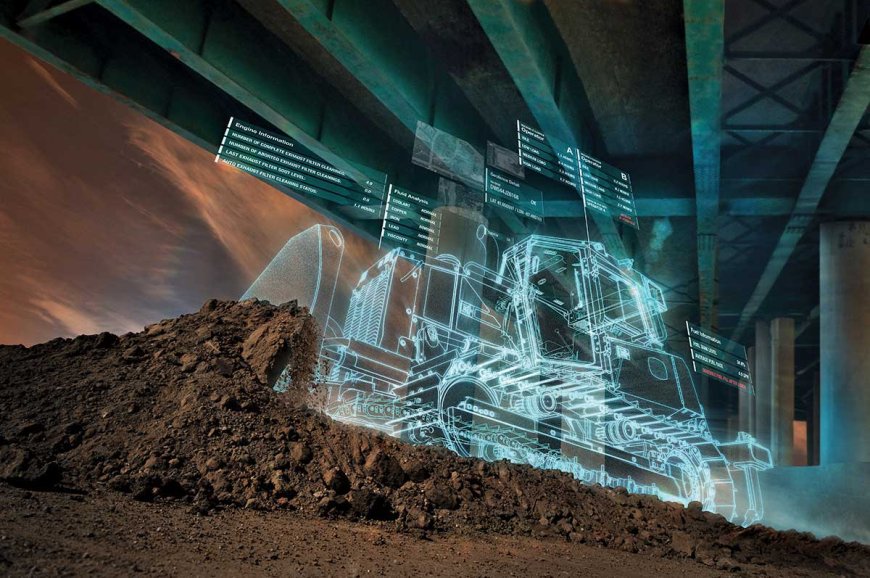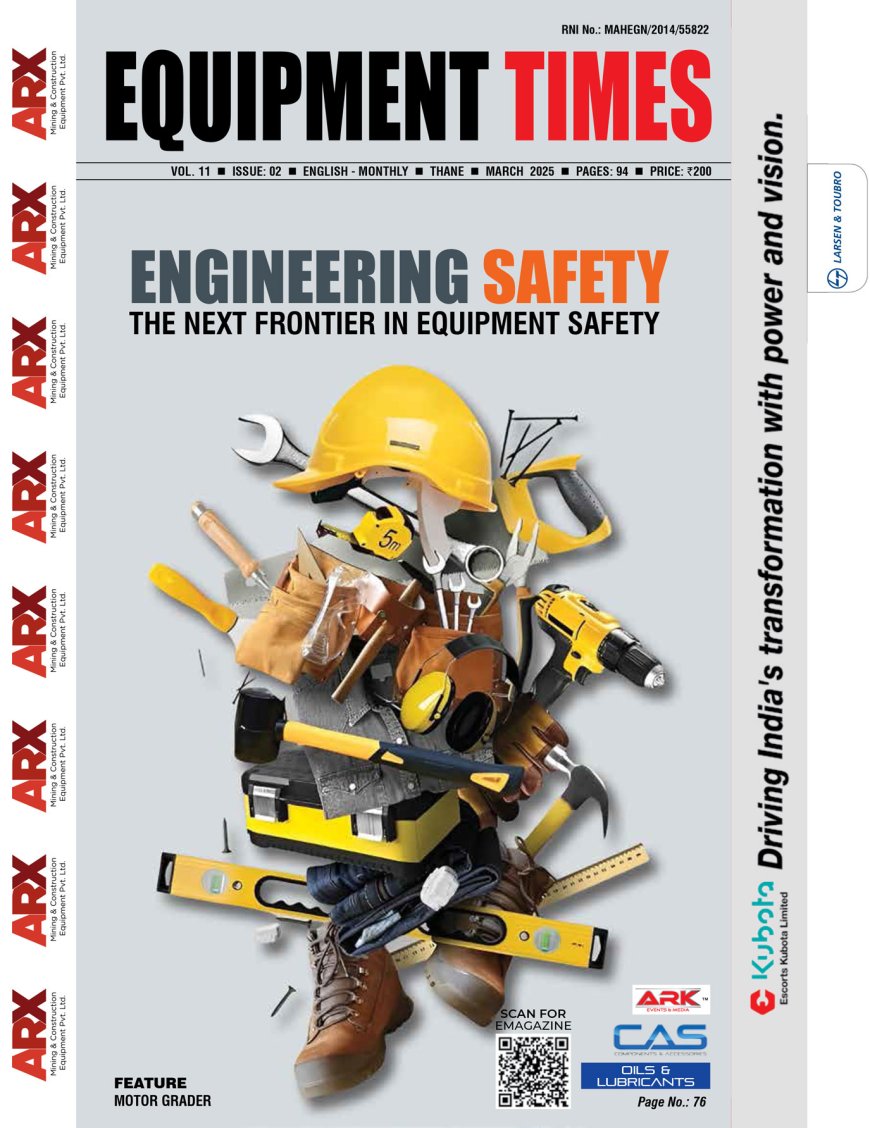TECH TRENDS IN CONSTRUCTION EQUIPMENT
From smartphones to virtual reality, technology is disrupting our daily lives. Technology is also impacting the way we work. In recent years, we’ve seen machinery evolve, becoming smarter, using less fuel and producing fewer emissions. Using telematics, today’s equipment can

From smartphones to virtual reality, technology is disrupting our daily lives. Technology is also impacting the way we work.
In recent years, we’ve seen machinery evolve, becoming smarter, using less fuel and producing fewer emissions. Using telematics, today’s equipment can also communicate — tell us when a repair needs to be made, set limits on how deep an operator can dig, or alert the owner if someone tries to steal it.
It’s downright amazing how smart technology is beginning to impact the construction industry in diverse ways. So, what’s next? What does the future hold for construction equipment?
Autonomous construction equipment: Imagine a fleet of equipment that can either be operated remotely, or without an operator at all. That day is coming!
Smart technology: The data that equipment is producing today is just scratching the surface of what’s possible. In the future, different machine components will be able to communicate with each other further enhancing telematics and predictive systems.
Fuel savings: Machinery is getting lighter and more efficient, helping to reduce operating costs, without sacrificing performance.
To achieve these future development milestones, is working side-by-side with OEMs and contractors alike to research, collect data and conceptualize tires, tracks and track systems that will be able to meet the demands of tomorrow’s advanced construction equipment. We believe that what propels a machine, provides flotation, traction and stability, are tires and tracks, and act as a vital component of these construction technology trends. For a better look at why, we need to dig deeper into each of these trends.
Pandemic drives new customer experience
From remote service to “contactless” demos and test drives, manufacturing has gone to great lengths in its attempts to modify existing operations so that it can meet customer needs in a “Covid safe” manner. And with customers becoming more accustomed to these offerings, and workers becoming more comfortable with these new methods, expect the manufacturing industry to further integrate these alternatives into its long-term approaches.
This will allow manufacturers to not only deliver more personalized service, but it will also give them the opportunity to further diversify their operations and build new workforces.
New tech officially becomes “mainstream”
The Covid-19 pandemic has caused the manufacturing industry to scrutinize its entire infrastructure and operations. And with that, manufacturing businesses are beginning to more widely embrace sophisticated computing technologies to help them optimize weaknesses that may have been uncovered during the Covid era.
For example, more and more manufacturers are beginning to embrace IoT technology to provide greater verification of sourcing provenance, while others are looking at ways in which technology, such as AI, ML, and IoT, can be used to support remote workforces to make them more agile and effective. This means that 2021 could be the dawn of a manufacturing sector that looks much different technologically from anything that we have seen in the past.
A new dawn for network collaboration
Across all industries, collaboration in consumer and enterprise markets has become a necessity for incumbents to retain market share due to significant encroachment from digital disruptors. And the manufacturing sector will need to embrace the same approach moving forward.
To remain competitive, manufacturers need to shift from the traditional linear contracts in the supply chain to multiparty collaborative partners with greater focus on services end-customer demands.
R&D Focused on Improving Performance, Operability, & Sustainability
Industry leaders are currently developing the next generation of construction equipment – ranging from alternative fuel trucks and semi-autonomous excavators – which will be considerably more productive, efficient, and environmentally friendly. New models will feature a variety of innovative technologies, such as advanced sensors, electric engines, and sophisticated data collection capabilities.
Technological advancement is the need of every sector and this holds true for the Construction Equipment (CE) sector as well. While in the past decade, lot of technological advancements have taken place in the CE segment in the country, yet there is a long way to go.
Need for technological advanced CE
Globally, India has become one of the key potential markets for Construction Equipment (CE). Further, it is estimated that by 2025, India’s construction market will emerge as the third largest in the world, which would exhibit huge demand for CE equipped with latest technology, owing to the advantages offered by them.
Let’s take a look at the various advantages offered by technological advanced CE:
- Timely completion of projects: Usually we see construction projects witnessing delays in execution. The main reason behind project delays is usage of less advanced machines. Hence, works in construction field can get smoother and faster with the help of equipment fitted with cutting-edge technologies, which can ensure project completion in given deadline.
- Enhances brand value: If projects are completed on time using highly advanced equipment, the brand value of business increases in the market, which in turn can help in getting new clientele.
- Improves quality of work: Employing CE with latest technology also allows contractors to complete work with minimal quality defects.
- Cost savings and profitability: Increased productivity and the reliability of the advanced CE also translates into higher profitability from fewer defect-related claims and the avoidance of delay penalties.
- Performs multiple tasks: An old equipment may not be capable of doing all the work but machine embedded with advanced technology can do similar work and may be few other tasks as well smoothly in less time.
- Ensures environmental friendliness: Generally CE equipped with latest technology are environment friendly and highly fuel efficient. Thus, they help in reducing CO2 considerably and help companies put their greener foot forward.
- Reduces maintenance cost: Last but not the least, CE equipped with latest technologies require less maintenance. They are designed in such a way that they can work for long without major wear and tear.
How the industry is reshaping the technological future…
Speaking about how have technologies positively impacted the site management as well as productivity, reliability and efficiency of construction machines, M. V. Rajasekhar, Director (Mining & Construction), BEML, said, “The positive impact of Technological advancement with respect to site management, productivity, reliability and efficiency can be illustrated as below:
- Timely completion of projects: Usually we see construction projects witnessing delays in execution. The main reason behind project delays is usage of less advanced machines. Hence, works in construction field can get smoother and faster with the help of equipment fitted with cutting-edge technologies, which can ensure project completion in given deadline.
- Enhances Brand Value: If projects are completed on time using highly advanced equipment, the brand value of business increases in the market, which in turn can help in getting new clientele.
- Improves Quality of Work: Employing CE with latest technology also allows contractors to complete work with minimal quality defects.
- Cost Savings and Profitability: Increased productivity and the reliability of the advanced CE also translates into higher profitability from fewer defect-related claims and the avoidance of delay penalties.
- Performs Multiple Tasks: An old equipment may not be capable of doing all the work but machine embedded with advanced technology can do similar work and may be few other tasks as well smoothly in less time.
- Ensures Environmental Friendliness: Generally, CE equipped with latest technology are environment friendly and highly fuel efficient. Thus, they help in reducing CO2 considerably and help companies put their greener foot forward.
- Reduces Maintenance Cost: Last but not the least, CE equipped with latest technologies require less maintenance. They are designed in such a way that they can work for long hours without major wear and tear.”
When asked about the customer preferences in terms of technology in construction Equipment, he said, “In today’s highly competitive market, customers are seeking for highly reliable equipment. The demand is for technological advanced and best performing equipment with high productivity, low operating cost, low maintenance and high reliability. The present market scenario calls for major improvements particularly with respect to operator comfort and ease of operations with maximum use of automated electronic gadgets and instrumentation. In addition to this, there is an immediate requirement to make the operations failsafe and ensure maximum productivity. Higher productivity with optimum fuel efficiency is the prime requirement for any customer and manufacturers incorporate features that help to achieve this objective. Electronic and mechatronic controls play a vital role in this regard.
In general Customer looks for Fuel level information, Machine utilization report, Critical machine health alerts, Service reminder and Payload monitoring”
Commenting on the major challenges in replacing the legacy systems with new technologies in construction equipment and Is cost a deterrent, Rajasekhar said, “Technology is evolving rapidly. Something that’s state-of-the-art today may be woefully obsolete in a year or so. Learning how to use new tools, especially when you’re comfortable with what you’re used to, can be time-consuming and frustrating. Plus, implementing a new infrastructure can be costly and has the potential for major business interruptions. While moving from legacy system to advance technology it is inevitable to invest on training the people for a comfortable adaptation of the new solution. Furthermore, it is a bit challenge for a business to deal with the cost when looking for the adoption of new technology. That is why it has become so critical to invest in standards-based technology which will make the component affordable, investment on generic training on electronic system etc., If the company is spending more on a legacy system in the initial stage, it may be difficult for the company to operate in the future.
In general, the challenges are, project cost control, absence of skilled maintenance staff and operator and require extensive training, absence of matured indigenous technology which intern attracts import of powerline aggregates, hydraulic system, electronic control system.”
Deepak Shetty, CEO & Managing Director, JCB India, said, “Technology has been transforming the way machine-to-machine and machine-to-customer communication is being done. All vital information about the machine is available to customers on their mobile devices through a web browser or also through the ‘LiveLink’ mobile application. Additionally, the system also sends out alert SMSs to registered mobile numbers. It incorporates GPS, telecommunications, machine electronics and IoT, enabling the equipment to remain in contact with the owner, dealer and JCB. Accurate monitoring of machine-hours and service alerts improve maintenance. Technical alerts and maintenance history data helps customers manage the machine’s health for maximum uptime and return on investment. Early warnings with detailed machine history enable users to plan work effectively.
According to Ramesh Palagiri, Managing Director & CEO, Wirtgen India, “The Wirtgen Group is the world leader in advanced technologies that conserve resources through reuse and recycling of construction materials. Wirtgen has the right equipment for productive and profitable asphalt and concrete construction materials recycling, ranging from wheeled and tracked cold recyclers. In the cold recycling process, 100 percent of the reclaimed material can be reused and cost-effectively treated, making cold recycling both an economical and an environmentally friendly option. VÖGELE have introduced several innovations like the pressure bars & electric heating of the screed, Niveltronic plus operating concept and ergo plus operator features. Dash -3 pavers, Eco plus, Autoset plus, Pave dock assistant etc. are additional features and helps in saving fuel etc. VÖGELE also offers several other innovative products like the Mobile feeder used for building of airport runways and expressways and also the In line paving technology.”
E. Moses, Vice President – Division & National Head, Kobelco Construction Equipment India, said, “Telematics was introduced on our machines in India almost a decade back but the Users took some time to understand its utility in better managing their fleet. The advent of smartphones has contributed a lot towards the increased usage of telematics data by the machine owners. They are able to track their machine data from any location and can see the machine location as well as various useful performance data like machine utilization, idle times, fuel consumption, operating modes used, service maintenance alerts, etc.”
V. Senthilkumar, Managing Director – Propel Industries, said, “Our customers have welcomed the use of new technology in construction equipment. For example, customers get Auto-SMS alerts when there is a problem in the machine. They can also monitor machine productivity and performance remotely. This is of immense help in plant management and helps customers control running costs and improve plant uptime. Customers are able to optimise the performance of the plants through timely change of wear parts.”
Sharad Thussu, Head – Mining & Construction Equipment Division at Voltas, said, “The construction equipment industry is undergoing significant transformation. The expectations of the consumers are changing, with new and possibly revolutionary technologies and trends being introduced including Building information modelling (BIM), construction robotics, and the utilisation of innovative building materials. Technologies like Telematics helps to enact route planning tools along with reducing fuel consumption which leads to efficient movements of the machines. On the other hand, IoT and Big Data have assisted in optimizing work performance and enables the site managers to give real-time instruction to their team members while also lowering the number of injuries. It has also helped us to streamline the processes resulting in reduction of waste generated by the machines and has also aided the company in removing redundancies which have improved the efficiency of the construction machines.”
He further added, “Voltas’ engineering ingenuity increases productivity while ensuring safe and sustainable operational practices. Our customers now prefer innovative tools and machinery and Voltas being a consumer-centric brand incorporates smart engineering for smart execution to make a positive difference with predictive maintenance. However, there are certain challenges that we face while incorporating such technologies including shortage of skilled personnel, sluggish productivity, and safety concerns. There is a necessity to have standard protocols that will boost productivity, reduce workplace injuries, and set a standard in the industry. Replacing legacy technology is difficult, but it is necessary for a company to keep up with evolving technologies and customer demands. Employees are having a hard time adapting to the changes in the old system. The most difficult task is incorporating new features into existing legacy technologies (web application, mobile app) rather than starting from scratch. Even though the construction sector has been slow to adopt automation developments in comparison to other industries, automation will assist improve important areas such as cost, schedule, quality, safety, and productivity.”
Saurabh Kulkarni, Mobile Automation Expert India, B&R Automation, said, “In the last two decades, the industry has come a long way, starting with manual drawings and evolving to include various innovative technologies. While technology is not always beneficial to each industry, for construction and excavation, which has come an extended way from manual digging with shovels, exponential growth is on the horizon. The Industrial Revolution sparked the primary attempts to automate the task of soil removal and grading. Over the years, the strain placed on excavation processes has changed dramatically. On top of ever-increasing demands on operational efficiency and quality, these industries require an automation system that is both powerful and scalable. B&R’s proven mobile automation lineup gives you all the tools you need to build and defend your competitive edge as a technological leader in your market. Evolving with an innovation-driven technology partner at your side, your mobile equipment stands out with best-in-class electronics and software.”
Hits: 45










